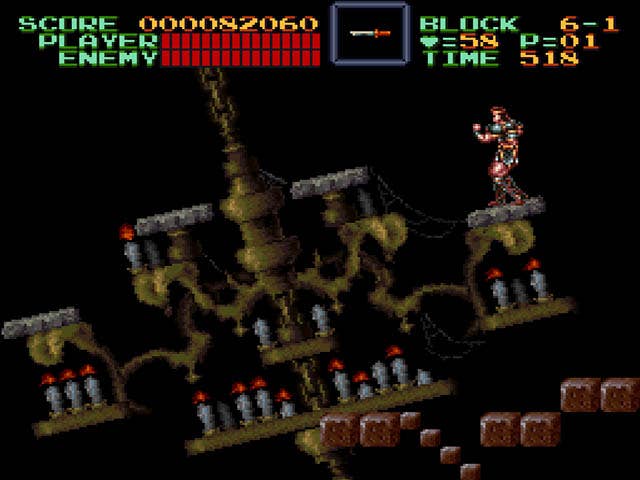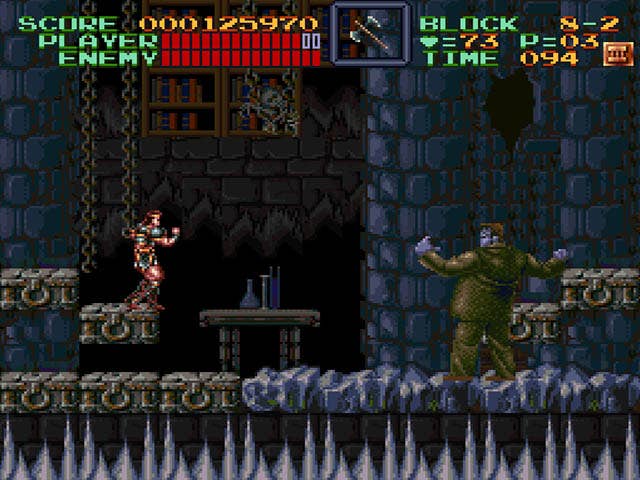Super NES Retro Review: Super Castlevania IV
Join us as we review every Super NES Classic game. Next up: Simon Belmont's excellent adventure.
This article first appeared on USgamer, a partner publication of VG247. Some content, such as this article, has been migrated to VG247 for posterity after USgamer's closure - but it has not been edited or further vetted by the VG247 team.
Join us as we review all the games on the SNES Classic Mini Edition in chronological order!
Like Super Mario and Mega Man, vampire hunter extraordinaire Simon Belmont was overhauled for his brave new 16-bit world. Unlike other mascots who ascended from 8- to- 16-bits, however, Simon's new look and skillset lasted for a single game.
Super Castlevania IV's disparity is part of its appeal, though. The NES Castlevania games share a distinct aesthetic, and the 2D Castlevania titles following Castlevania IV all inherited key traits from their great-grandfather, Rondo of Blood for the PC Engine. But Castlevania IV's subdued color palette, percussion-heavy soundtrack, and loose whip-handling is one of a kind.
Castlevania IV is probably also the last Castlevania title to use a light touch with its story. Dracula is back, and Simon Belmont needs to put him down. That's about it. In fact, Japan regards Castlevania IV as a reboot of Simon's debut adventure, and both narratives work just fine.
Castlevania IV's seeming lack of a driving story never bothered me, because the game's visuals tell you more about Dracula's haunted manor than reams of text ever could. I still look back at Castlevania IV with a bit of disbelief; a first-generation SNES game has no right to look so good. While Simon's sprite looks kind of weird and arthritic, the areas he trudges through are filled with details both tiny and huge. In the opening stage alone, ivy crawls up tall fences at an unnatural speed, and ghostly horses swish their tails as they watch Simon pass. Later stages play with the SNES's Mode-7 graphics by turning whole rooms on a single pixel, and by rocking massive chandeliers back and forth (wavering candle flames and all). Eat that, Phantom of the Opera.

Castlevania IV is as linear as the first NES game. Gone are the branching paths of Simon's Quest and Castlevania III. The game never makes you feel fenced-in, though; there are eleven levels, most of which are broken up into sub-sections that contain entirely new settings and music. Though not as massive as Super Mario World, first-timers probably won't be able to clear Castlevania IV in a single sitting.
Interestingly, there's a rhyme and reason to Castlevania IV's sprawl. Before Simon is allowed access to the Count's castle, he needs to trek through his huge estate. Hence the haunted stables, the clockwork mansions, the gardens, the caverns, the shallow rivers, and the rest of it. Though Castlevania IV predates Symphony of the Night by several years, it might be the first game in the series that makes Simon's eternal rival feel like less of a Universal Monsters stereotype and more like the twisted Wallachian warlord that Dracula's legend is based upon.

That may also be why Castlevania IV lets Dracula's castle appear almost normal at times, but pulls the rug out from under you before you get too comfortable. The castle's ballrooms are filled with ghosts, its library is filled with living statues and paintings, and its most affluent quarters are reserved for Dracula's own personal bodyguards: The demons Slogra and Gaibon, and Death itself.
Even the most secret corners of the Master's abode aren't free of wraiths. Astute players may discover a treasure room in level six that contains a ghostly old man and his dog. If Simon kills the dog, the man weeps over its corpse until both pass into eternity.
The treasure room is hard enough to find on its own. There's no reason for the old man and his dog to have their own little narrative tucked away in that obscure crevasse. Nevertheless, they do. It's just one of a million little touches that make Castlevania IV feel timeless despite its age.

The unique whip mechanics at the core of Castlevania IV also make the game a blast to return to time and time again. Simon still plods along like Mr Heavyfoot, but his ability to whip in eight directions – an ability exclusive to Castlevania IV – makes the game's platforming much more malleable, especially when combined with Simon's traditional repertoire of sub-weapons (throwing knives, holy water, the cross boomerang, et al). Cheap deaths are less of an issue when you can whip diagonally at a writhing dragon skeleton from the safety of a lower platform.
Simon can also grab onto special rings with his whip and swing back and forth like another adventurer of note. This mechanic is used to great effect in the Clocktower level, which, by the way, has the best song on a soundtrack that's singularly stunning. Not even Symphony of the Night offers anything as haunting as the music that accompanies Simon's final throw-down with Dracula.
Castlevania IV is a nearly-perfect package. Its graphics, sound, and gameplay are as solid as Dracula's front gate. It's a rare example of a game that's worth buying several times over because it should always be near you. No matter how many times I come back to it, I still get a thrill out of watching the gates rise on Dracula's front lawn and listening to Simon's Theme build up. Castlevania IV really whips the vampire's – ah shoot, Mike already took that joke.
ConclusionCastlevania IV is one-of-a-kind. There's no other Castlevania game that looks or plays quite like it, and it's deeply satisfying to work through. This is action game aristocracy.

